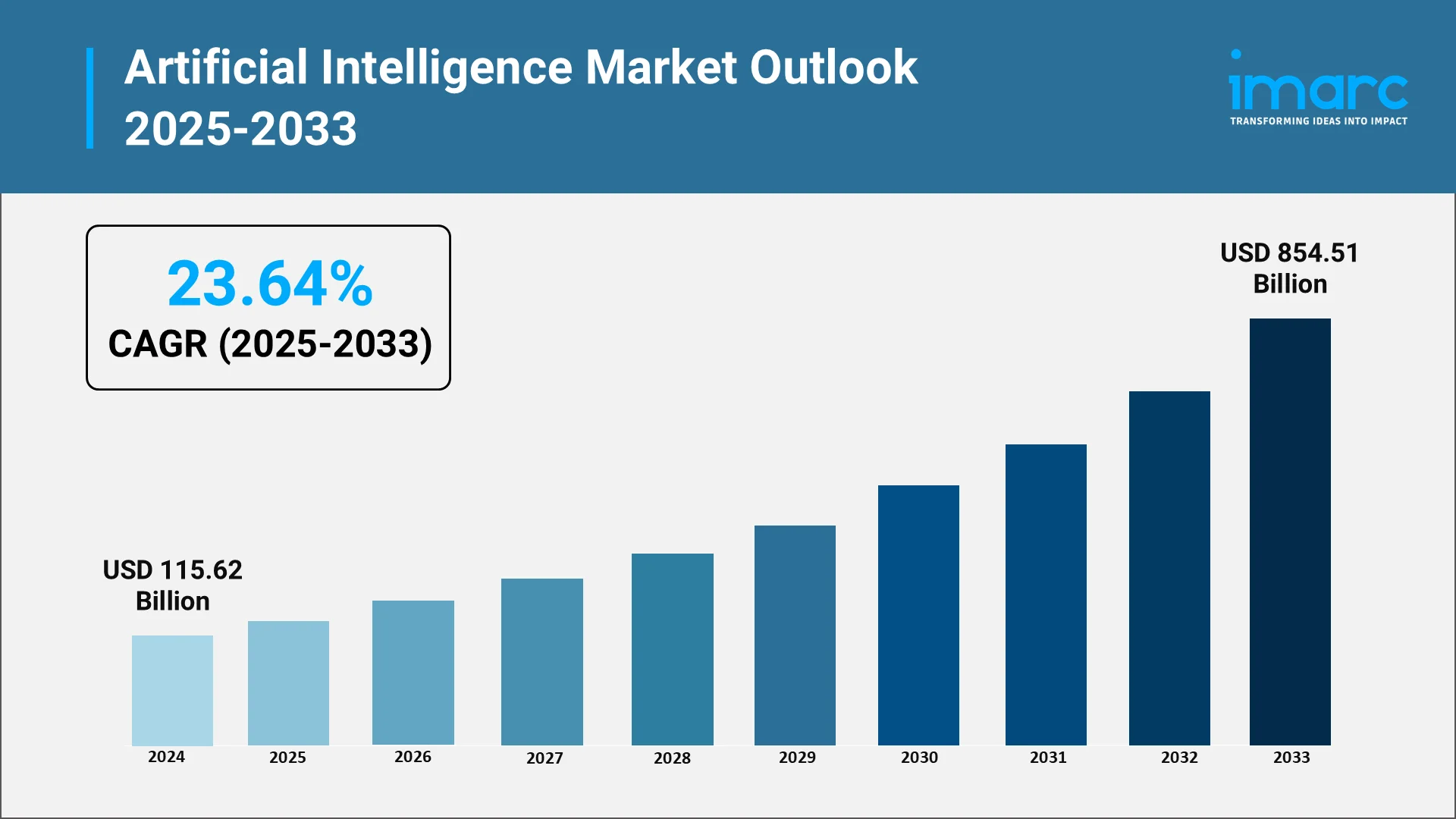Top 10 Key Benefits of Using AI to Boost Business Performance
.webp)
AI’s Growing Influence on Today’s Enterprises:
The artificial intelligence market is no longer niche. Current projections value the market at a significant level today, with strong growth expected as generative AI matures, computing costs decline, and enterprise pilots scale into full production. The global artificial intelligence market size reached USD 115.62 Billion in 2024. Looking forward, IMARC Group estimates the market to reach USD 854.51 Billion by 2033, exhibiting a CAGR of 23.64% from 2025-2033. Technological innovation, robust infrastructure, strong governmental support, and increasing investment in research and development (R&D) are some of the factors propelling the growth of the market.
Momentum is visible in real operating results. NVIDIA’s data center revenue surged to a quarterly record in fiscal Q2 2025 on AI demand, highlighting how quickly infrastructure is being built to support business use cases. What follows are the top ten benefits leaders can capture now, with current examples and practical angles to apply in your setting.

Explore in-depth findings for this market, Request Sample
Sharper Decisions through Intelligent Data Use:
Benefit 1: Faster, better decisions from unified data and copilots
Decision quality improves when teams can interrogate data in plain language and receive suggested actions. Microsoft’s studies on Copilot users show measurable time savings in everyday work like email triage, drafting, and meeting prep, which compounds into faster decisions across departments. In June 2025, a UK government trial with more than 20,000 civil servants reported about 26 minutes saved per day, or roughly two weeks a year, using AI tools for drafting and summarizing.
Beyond time savings, organizations are reporting that decision consistency improves when copilots surface the same data sets to all f. Instead of siloed reports or outdated dashboards, leaders and frontline employees access a single version of truth enriched by natural language queries. This reduces debate over metrics and shifts attention to action. In healthcare, for instance, NHS pilots have shown clinicians gaining faster clarity on patient pathways when AI organizes clinical notes and presents options directly. In corporate strategy, boards are using copilots to analyze competitive filings or market signals in hours rather than weeks. These changes reduce lag between insight and execution.
Benefit 2: Risk and compliance decisions that reduce noise
Financial institutions show how AI filters signal from noise at a massive scale. HSBC reports materially fewer false positives in financial crime screening after deploying AI, which means investigators spend their time on the right cases and decisions reach closure sooner.
Other banks have published similar results. ING, for example, applied AI to transaction monitoring and cut investigation cycles by nearly 40 percent. Regulators are watching these programs closely, but initial feedback is positive: AI isn’t replacing oversight, it’s helping humans focus on meaningful anomalies. Outside finance, insurers are adopting copilots for claims triage, reducing both fraud exposure and settlement delays. The broader theme is noise reduction, stripping out low-value alerts so scarce expert attention can be used effectively.
Where to apply it: Deploy copilots in analytics and office suites, connect to governed data sources, and define clear decision rights so AI outputs translate to accountable choices.
Tailoring Customer Journeys with Precision:
Benefit 3: Always-on service with an AI chatbot that actually resolves issues
In March 2024, Klarna’s customer-service assistant, built on OpenAI tech, quickly scaled to handle about two-thirds of incoming chats and a workload comparable to hundreds of agents, with management citing multi-million-dollar profit impact expectations. This is a modern pattern for retail and fintech service desks that need 24×7 coverage.
In December 2024, based on case studies, airlines also standardized on assistants for bookings, updates, and claims. Mature deployments include KLM’s BlueBot and others across the industry, which reduce agent load and cut response times.
Telecoms and utilities are following a similar path. Vodafone’s AI chatbot assistant now manages millions of monthly support interactions across Europe, resolving billing issues and technical queries. Customers get faster answers, while service teams can reallocate staff toward retention or upsell. The ability to offer consistent quality around the clock also helps firms expand globally without scaling call centers proportionally.
Benefit 4: Tailored journeys that lift conversion
Personalization engines powered by artificial intelligence match content, offers, and timing to individual behavior. Mastercard describes AI-driven personalization tools that guide shoppers to relevant products and improve checkout outcomes, while maintaining strong risk controls.
Retailers such as Nike and Sephora have experimented with AI-driven recommendations that adapt in real time based on browsing, store visits, and loyalty data. Airlines are using similar tools to nudge travelers toward upgrades or ancillary purchases at the right moment. The difference from older personalization is granularity: AI models can combine hundreds of behavioral signals instantly, predicting intent with far greater accuracy. Companies report double-digit lifts in email open rates and conversion when personalization is deeply embedded into the journey.
Where to apply it: Launch a tiered virtual agent that starts with high-volume intents, integrate retrieval into your knowledge base, and set service-level goals, such as first-contact resolution.
Elevating Performance across Operations:
Benefit 5: Productivity gains across knowledge work
Enterprise copilots in email, documents, and presentations are delivering hours back to staff. In June 2025, the UK public sector trial signaled broad applicability beyond tech firms, and Microsoft’s Work Trend research shows similar patterns in private companies adopting generative AI assistants. Even modest weekly time savings add up significantly across thousands of employees.
Anecdotally, managers report fewer late-night document edits and more time for creative work. Marketing teams can draft campaigns faster, legal departments shorten contract review, and HR can personalize communications without manual effort. These time shifts are reshaping workplace rhythms: meetings are shorter because prep is automated, and decisions happen faster because data briefs are pre-generated.
Benefit 6: Automation on the warehouse floor and in the field
In February 2025, Amazon expanded its fleet to more than 750,000 robots with AI-driven systems like Sparrow and Proteus to sort, pick, and move items, supporting faster fulfillment and projected cost savings through the decade. These systems show how artificial intelligence companies blend computer vision and planning to handle complex physical tasks.
Predictive maintenance adds another layer. Manufacturers report reduced unplanned downtime when machine learning models forecast failures ahead of time, enabling planned interventions and higher line availability.
Automakers are also embracing AI-driven robotics for assembly and quality control. BMW’s use of AI vision systems has caught thousands of defects earlier in the production line, reducing costly recalls. In energy, field technicians now rely on copilots to guide inspection tasks and document compliance on site. This reduces paperwork and accelerates repair cycles, adding efficiency to industries with high capital intensity.
Where to apply it: Run a 90-day pilot that targets a single high-impact process. Measure baseline throughput and error rates, then quantify the uplift after deploying the model or copilot.
Smarter Spending and Strategic Resource Use:
Benefit 7: Lower service and back-office costs per ticket
When a virtual agent resolves routine queries end-to-end, you can reassign human agents to complex cases. In March 2024, Klarna’s rollout illustrated the rapid cost curve shift possible when an assistant handles millions of monthly interactions with human-level satisfaction.
Other industries are replicating this model. In healthcare, hospital systems are using AI assistants to manage appointment scheduling, billing questions, and follow-ups, cutting call-center costs significantly. Universities have deployed similar bots for admissions and financial-aid queries, reducing seasonal staff surges. Each ticket resolved by AI doesn’t just save labor; it shortens resolution time, improving customer experience while freeing skilled staff for strategic work. Companies that scale assistants across HR, IT help desks, and procurement often see cost reductions compound across back-office functions.
Benefit 8: Energy and infrastructure savings
Optimization models trim energy use in heavy operations. In July 2025, Schneider Electric teamed up with NVIDIA to create AI-optimized data center architectures, using liquid cooling and high-density rack designs, which cut cooling energy by around 20% and shortened development timelines by about 30%.
Beyond data centers, manufacturers are applying similar optimization models to HVAC and process control in plants, trimming operational overhead and supporting sustainability targets. Retailers are doing the same with refrigeration and lighting systems across large store networks. Logistics firms are deploying route optimization to reduce fuel costs, and office facilities teams use AI occupancy sensing to adjust space usage dynamically. These real-world savings compound into both direct cost reductions and measurable ESG progress, which resonates strongly with investors and regulators.
Where to apply it: Calculate the total cost of ownership for agent and automation programs, including model inference costs. Tie budgets to measured savings and reinvest a portion into new AI use cases.
Safeguarding Systems with Advanced AI Defense:
Benefit 9: Real-time fraud interdiction with generative AI and graph models
Payment networks are deploying new generative AI scoring to flag enumeration and account-testing attacks at the edge. In May 2024, Visa’s VAAI Score evaluated up to hundreds of risk attributes in milliseconds to predict attacks, and Mastercard reports doubling the speed at which it detects potentially compromised cards. These are high-scale, high-stakes deployments that demonstrate AI’s defensive value.
Banks are pairing this with better anomaly detection in security operations platforms. Microsoft Sentinel’s ML-driven baselines help analysts spot unusual behaviors across the kill chain, improving mean time to detect.
The threat side is intensifying too. In August 2025, JPMorgan warned that AI-driven scams are growing rapidly, which increases the urgency for companies to strengthen controls and customer education.
Where to apply it: Start with a focused fraud use case aligned to clear loss metrics, integrate behavioral biometrics, and put human-in-the-loop review on top of model thresholds.
Opening Pathways to Innovation and Growth:
Benefit 10: New products and experiences at speed
Consumer brands and industrial firms are moving beyond pilots into platform-level generative AI initiatives. In April 2024, Coca-Cola committed to a multi-year program with Microsoft to build new AI use cases across marketing, commerce, and operations, reflecting how large incumbents modernize offerings with AI-native services.
In March 2025, Siemens’ Industrial Copilot brought generative AI into engineering, code generation for controllers, and service workflows. Recognized with awards in 2025, this approach points to a future where engineers co-create with AI to compress cycle times and launch more variants without adding headcount.
Edtech shows similar momentum. In August 2025, Duolingo shipped AI features and continued strong user growth, a sign that well-designed AI experiences can deepen engagement and open premium tiers.
Where to apply it: Use product discovery sprints with an AI engineer and a domain lead. Develop focused prototypes that demonstrate user value within weeks, not months.
Conclusion:
AI in 2025 is moving from pilots to production. GenAI, automation, and decision support are being built into everyday workflows across finance, retail, healthcare, manufacturing, and logistics. Standards for security, privacy, and responsible use are rising, and data quality remains a gating factor. Companies that prioritize clear use cases, strong change management, and tight measurement see faster payback. IMARC provides targeted research and advisory to help you prioritize, build, and scale AI programs that drive growth and efficiency.
How IMARC Can Help:
IMARC Group helps companies turn AI into real business results. We combine market research with hands-on execution support so you can identify the right use cases, size the value, and implement with confidence.
Our capabilities include:
- AI opportunity sizing and market forecasts by sector
- Feasibility and ROI studies for automation, copilots, and analytics
- Peer benchmarking, adoption scorecards, and SWOT analysis
- Mapping of high-value use cases across functions and regions
- Data, privacy, and model-risk support to meet regulatory requirements
- Technology evaluation and partner selection across models, platforms, and integrators
Whether you’re launching a pilot, scaling AI across teams, or upgrading your data foundations, IMARC helps you cut risk and capture measurable gains.
Our Clients
Contact Us
Have a question or need assistance?
Please complete the form with your inquiry or reach out to us at
Phone Number
+91-120-433-0800+1-201-971-6302
+44-753-714-6104
.webp)










